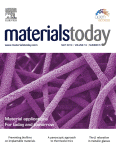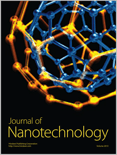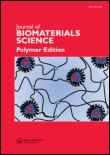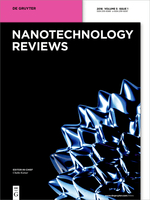
Frontiers in Nanotechnology
Scope & Guideline
Transforming Ideas into Nanotechnology Breakthroughs
Introduction
Aims and Scopes
- Nanomaterials Synthesis and Characterization:
The journal emphasizes studies on the synthesis of various nanostructures, including metallic, semiconductor, and hybrid nanomaterials, along with their characterization techniques to understand their properties. - Biomedical Applications of Nanotechnology:
Research articles often explore the use of nanomaterials in drug delivery, cancer therapy, diagnostics, and other medical applications, highlighting how nanotechnology can revolutionize healthcare. - Environmental and Energy Applications:
The journal publishes studies on the application of nanotechnology in environmental remediation, energy production, and sustainability, showcasing how nanomaterials can address global challenges. - Nanotechnology in Agriculture:
There is a significant focus on the role of nanotechnology in improving agricultural practices, including the use of nanoparticles for pest control, soil enhancement, and crop yield improvement. - Computational and Theoretical Approaches:
The journal also covers computational studies and theoretical models that enhance the understanding of nanostructures and their behaviors, contributing to the design of new materials and devices.
Trending and Emerging
- Nanomedicine and Targeted Drug Delivery:
There is a rising trend in the development of nanomedicine, particularly in targeted drug delivery systems that enhance therapeutic efficacy while minimizing side effects, reflecting the increasing need for personalized medicine. - Sustainable Nanotechnology:
Research focusing on sustainable practices in nanotechnology, including green synthesis of nanomaterials and their applications in environmental remediation, is gaining traction as global sustainability concerns rise. - Nanotechnology for Infectious Diseases:
The COVID-19 pandemic has sparked significant interest in the application of nanotechnology for the development of diagnostics, vaccines, and antiviral therapies, leading to a surge in related publications. - Smart Materials and Devices:
There is a notable increase in research related to smart materials that respond to environmental stimuli, as well as devices leveraging nanotechnology for advanced functionalities in fields like electronics and healthcare. - Integration of AI and Nanotechnology:
The intersection of artificial intelligence and nanotechnology is emerging as a significant trend, with studies focusing on the use of machine learning and computational methods to design and optimize nanomaterials and devices.
Declining or Waning
- Traditional Nanomaterials for Conventional Applications:
Research focusing solely on traditional nanomaterials, such as bulk metallic nanoparticles with limited novel applications, is increasingly being overshadowed by studies exploring innovative materials and multifunctional applications. - Basic Nanotoxicology Studies:
While the safety of nanomaterials remains important, the publication of basic toxicology studies without significant advancements or applications has decreased, as researchers are now focusing on specific applications and real-world implications. - Nanotechnology in Electronics without Integration:
Research articles that discuss nanotechnology applications in electronics without integration into larger systems or practical applications are becoming less frequent, as more emphasis is placed on the practical implications and integration of these technologies.
Similar Journals

Materials Today
Fostering Collaboration in the World of MaterialsMaterials Today is a premier academic journal published by Elsevier Science Ltd, specializing in the dynamic fields of materials science, mechanical engineering, and condensed matter physics. Established in 1999, the journal has garnered an enviable reputation, consistently ranking in the Q1 category across multiple disciplines including mechanics of materials and general materials science, reflecting its influence and high-quality research output. With an impressive Scopus ranking—4th in both mechanical engineering and mechanics of materials, and 6th in condensed matter physics—Materials Today serves as an essential resource for researchers, professionals, and students seeking to stay at the forefront of developments in material innovations and applications. The journal is known for its commitment to publishing significant research findings and reviews, making it a vital platform for disseminating knowledge and fostering collaboration in the rapidly evolving materials field. Although it does not offer open access, its robust impact factor underscores the importance of the content published, ensuring wide visibility and citation among the academic community. Explore the rich tapestry of materials research with Materials Today, where groundbreaking insights pave the way for future technological advancements.

Physical and Chemical Aspects of the Study of Clusters Nanostructures and Nanomaterials
Decoding the Complexities of NanomaterialsPhysical and Chemical Aspects of the Study of Clusters, Nanostructures, and Nanomaterials is an esteemed open-access journal published by TVER STATE UNIVERSITY, dedicated to advancing the scientific discourse surrounding the intricate interplay of physical and chemical properties in nanostructure materials. Launched in 2017, this journal provides a vital platform for researchers, professionals, and students to disseminate and access cutting-edge findings in the rapidly evolving fields of nanotechnology and materials science. With an ISSN of 2226-4442 and an E-ISSN of 2658-4360, it aims to bridge the gap between academic research and practical applications. By facilitating open access to high-quality research, the journal plays an essential role in promoting innovative solutions to contemporary challenges in engineering, materials development, and related industries. The journal's scope includes but is not limited to the synthesis, characterization, and functionalization of nanomaterials, ensuring comprehensive coverage of this multidisciplinary field.

Journal of Nanotechnology
Leading the Charge in Nanotechnology ResearchThe Journal of Nanotechnology, published by Hindawi Ltd., is a premier open-access platform dedicated to delivering high-quality research in the dynamic field of nanotechnology. With the ISSN 1687-9503 and E-ISSN 1687-9511, this journal has been at the forefront of disseminating innovative findings since its transition to open access in 2009, fostering a global dialogue among researchers, professionals, and students. Based in Egypt, the journal maintains its commitment to advancing the material science sector, currently holding a prestigious Q2 ranking in the 2023 Materials Science (miscellaneous) category, reflecting its significant contribution to the field. With a Scopus ranking of #162 out of 463 journals in General Materials Science, placing it in the 65th percentile, the Journal of Nanotechnology serves as a crucial resource for those looking to explore the latest advancements and applications in nanomaterials. The journal invites submissions that align with its scope, which emphasizes interdisciplinary approaches and novel methodologies, promising to enhance both academic and practical aspects of nanotechnology.

JOURNAL OF BIOMATERIALS SCIENCE-POLYMER EDITION
Exploring the synergy of biomaterials and engineering.JOURNAL OF BIOMATERIALS SCIENCE-POLYMER EDITION, published by Taylor & Francis Ltd, is a distinguished scholarly journal dedicated to the exploration of biomaterials and their applications in various fields such as bioengineering, biomedical engineering, and biophysics. With an ISSN of 0920-5063 and an E-ISSN of 1568-5624, this journal offers a platform for researchers and professionals to share innovative findings and methodologies that advance the science of polymer-based biomaterials. The journal's impact within the academic community is underscored by its notable Scopus rankings, including a Q2 status in both Biomedical Engineering and Biophysics as of 2023, reflecting its significant contribution to advancing knowledge and practice in these fields. The scope of the journal spans from fundamental research to applications in medical devices and regenerative medicine, ensuring comprehensive coverage of the latest trends and breakthroughs. Although it does not currently offer open access options, the journal remains a pivotal resource for students, researchers, and professionals committed to the development and application of biomaterials in healthcare. For further details, the journal is based in Abingdon, United Kingdom, at 2-4 Park Square, Milton Park, OX14 4RN.

JOURNAL OF CLUSTER SCIENCE
Charting New Territories in Biochemistry and BeyondJOURNAL OF CLUSTER SCIENCE, published by SPRINGER/PLENUM PUBLISHERS, is a prominent and influential journal in the fields of Biochemistry, Chemistry, Condensed Matter Physics, and Materials Science. With an ISSN of 1040-7278 and E-ISSN of 1572-8862, this journal has been contributing to scientific discourse since its inception in 1990 and continues to publish cutting-edge research through 2024. It holds a respectable position in the academic landscape with its category quartiles indicating a Q3 ranking in Biochemistry and Q2 rankings in Chemistry, Condensed Matter Physics, and Materials Science as of 2023. The journal's noteworthy Scopus rankings further underscore its relevance, particularly a rank of #82 in Condensed Matter Physics, showcasing its impact and the quality of research disseminated. Although it does not currently offer open access options, it remains a key resource for researchers, professionals, and students who are invested in understanding the complexities of cluster science and its interdisciplinary applications.

Nanotechnology Reviews
Exploring the Boundaries of NanoscienceNanotechnology Reviews, published by DE GRUYTER POLAND SP Z O O, stands at the forefront of the multidisciplinary field of nanoscience and nanotechnology. With an Open Access model adopted since 2019, this journal, identifiable by its ISSN 2191-9089 and E-ISSN 2191-9097, disseminates vital research that is accessible to a global audience. The journal is located in Germany and has established itself as a premier platform for innovative research, boasting impressive quartile rankings: Q1 across several categories including Biotechnology, Energy Engineering, and Materials Science, as well as a Q2 classification in Biomaterials as of 2023. The diverse scope enables authors to contribute to a range of topics, from biomedical applications to energy solutions and advanced materials, making it essential reading for researchers, professionals, and students passionate about cutting-edge developments. Additionally, with Scopus rankings highlighting its value across various domains and robust percentiles, including 94 in Engineering (miscellaneous), 93 in Medicine (miscellaneous), and 88 in Biotechnology, Nanotechnology Reviews is an influential and respected journal that fosters scientific dialogue and innovation.

ACS Applied Materials & Interfaces
Exploring Breakthroughs in Materials Science and InterfacesACS Applied Materials & Interfaces, published by the American Chemical Society, stands as a leading journal in the field of applied materials, nanotechnology, and interdisciplinary research in medicine. With an impressive Impact Factor that places it in the Q1 category across Materials Science, Medicine, and Nanoscience and Nanotechnology, this journal consistently ranks among the top tier, evidencing its significance and influence in advancing scientific knowledge. The journal’s scopus ranking of 33 out of 463 in General Materials Science further underscores its critical role in disseminating innovative and high-quality research. Although it is not an open-access journal, a diverse range of access options is available, ensuring that vital research findings are accessible to a broad audience of researchers, professionals, and students. Targeting breakthroughs in the synthesis, characterization, and application of materials and interfaces, ACS Applied Materials & Interfaces serves as a pivotal platform for publishing cutting-edge studies essential for future technological advancements.

Nanoscience and Technology-An International Journal
Fostering Interdisciplinary Collaboration in NanotechnologyNanoscience and Technology-An International Journal, published by BEGELL HOUSE INC, is a leading platform dedicated to the rapidly evolving fields of nanoscience and nanotechnology. With its ISSN 2572-4258 and E-ISSN 2572-4266, the journal serves as a crucial resource for researchers, professionals, and students alike, focusing on advanced materials, condensed matter physics, and mechanics of materials. It holds a commendable position in the scholarly community, evidenced by its Q2 ranking in 2023 across multiple categories including Condensed Matter Physics and Materials Science. The journal aims to disseminate high-quality research, promote interdisciplinary collaboration, and facilitate innovation within the nano realm. With its convergence period from 2019 to 2024, it continues to attract a diverse array of studies and insightful contributions, reinforcing its importance in shaping the future of nanotechnology and its applications.

Nano Express
Fostering breakthroughs in biomaterials and beyond.Nano Express is an esteemed open-access journal published by IOP Publishing Ltd, dedicated to advancing research in the fields of nanotechnology and materials science. Since its launch in 2020, the journal has swiftly established itself as a vital resource for researchers and professionals, garnering significant recognition in various domains, including biomaterials, electronic, optical and magnetic materials, and polymers and plastics. With a commendable categorization in Scopus quartiles, it ranks in Q2 for Electronic, Optical and Magnetic Materials, and maintains a top percentile in several others, exemplifying its commitment to high-quality research dissemination. Located in the United Kingdom, this journal fosters a global dialogue among experts and newcomers alike, facilitating open access to innovative research that drives the future of nanotechnology. By offering a platform for groundbreaking studies and reviews, Nano Express aims to bridge the gap between theoretical understanding and practical application, championing the development of next-generation materials that have the potential to transform various industries.

Nano Convergence
Fostering innovation through the convergence of disciplines.Nano Convergence is a premier open access journal dedicated to the rapidly evolving fields of nanotechnology, materials science, and engineering. Published by SPRINGER, this journal has been at the forefront of interdisciplinary research since its inception in 2014, and is set to continue its journey until 2024. With an impressive impact factor and recognition as Q1 in both Engineering (miscellaneous) and Materials Science (miscellaneous) categories, Nano Convergence ranks among the top publications, listed as Rank #8 out of 307 in General Engineering and Rank #34 out of 463 in General Materials Science according to Scopus metrics. This journal provides a platform for researchers, professionals, and students to share pioneering studies that converge different disciplines within nanotechnology. With its commitment to open access, Nano Convergence ensures that cutting-edge research is readily available to the global community, fostering innovation and collaborative advancements in the field.